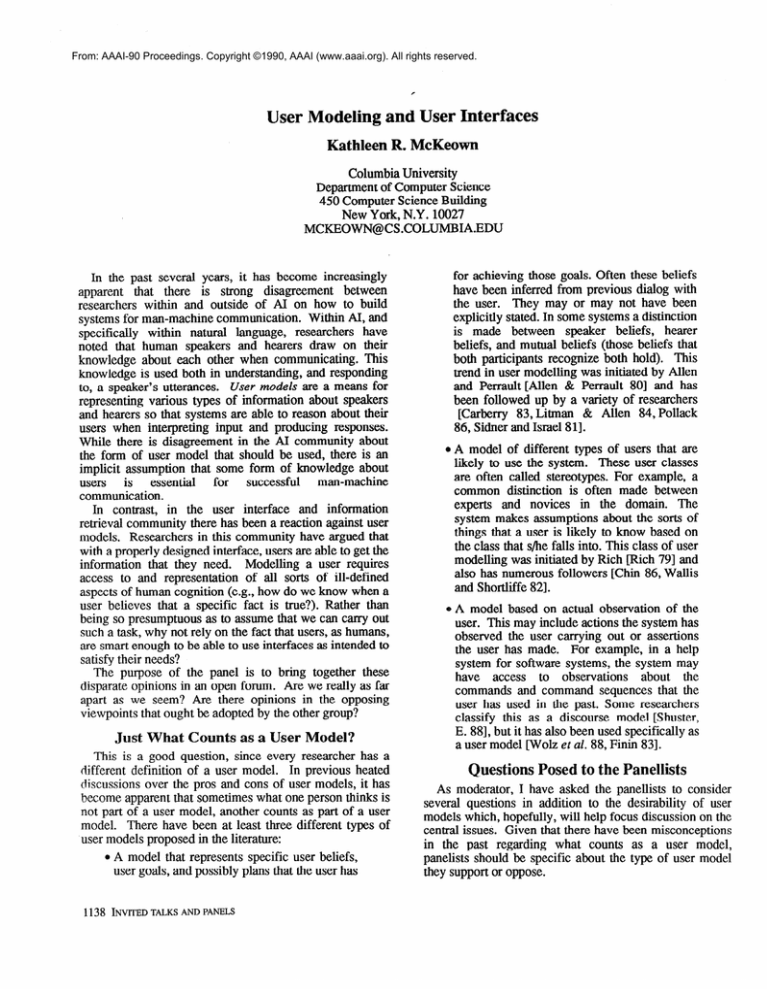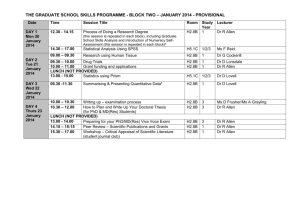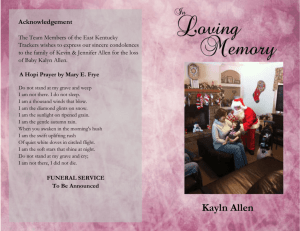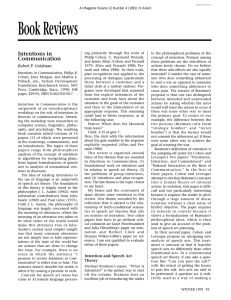
From: AAAI-90 Proceedings. Copyright ©1990, AAAI (www.aaai.org). All rights reserved.
User Modeling and User Interfaces
Kathleen R. McKeovm
Columbia University
Department of Computer Science
450 Computer Science Building
New York, N.Y. 10027
MCKEOWN@CS.COLUMBIA.EDU
In the past several years, it has become increasingly
apparent
that there is strong disagreement
between
researchers within and outside of AI on how to build
systems for man-machine communication.
Within AI, and
specifically
within natural language,
researchers
have
noted that human speakers and hearers draw on their
knowledge about each other when communicating.
This
knowledge is used both in understanding,
and responding
User models are a means for
to, a speaker’s utterances.
representing various types of information about speakers
and hearers so that systems are able to reason about their
users when interpreting
input and producing responses.
While there is disagreement
in the AI community about
the form of user model that should be used, there is an
implicit assumption that some form of knowledge about
essential
for
successful
man-machine
users
is
communication.
In contrast, in the user interface
and information
retrieval community there has been a reaction against user
models. Researchers in this community have argued that
with a properly designed interface, users are able to get the
information
that they need.
Modelling a user requires
access to and representation
of all sorts of ill-defined
aspects of human cognition (e.g., how do we know when a
user believes that a specific fact is true?). Rather than
being so presumptuous as to assume that we can carry out
such a task, why not rely on the fact that users, as humans,
are smart enough to be able to use interfaces as intended to
satisfy their needs?
The purpose of the panel is to bring together these
disparate opinions in an open forum. Are we really as far
apart as we seem ? Are there opinions in the opposing
viewpoints that ought be adopted by the other group?
Just What Counts as a User Model?
This is a good question, since every researcher has a
different definition of a user model.
In previous heated
discussions over the pros and cons of user models, it has
become apparent that sometimes what one person thinks is
not part of a user model, another counts as part of a user
model. There have been at least three different types of
user models proposed in the literature:
0 A model that represents specific user beliefs,
user goals, and possibly plans that the user has
1138
INVITED TALKS AND PANELS
for achieving those goals. Often these beliefs
have been inferred from previous dialog with
the user. They may or may not have been
explicitly stated. In some systems a distinction
is made between
speaker beliefs,
hearer
beliefs, and mutual beliefs (those beliefs that
both participants recognize both hold). This
trend in user modelling was initiated by Allen
and Perrault [Allen & Perrault 801 and has
been followed up by a variety of researchers
[Carberry 83, Litman & Allen 84, Pollack
86, Sidner and Israel 811.
0 A model of different types of users that are
likely to use the system. These user classes
are often called stereotypes. For example, a
common distinction
is often made between
experts and novices
in the domain.
The
system makes assumptions about the sorts of
things that a user is likely to know based on
the class that s/he falls into. This class of user
modelling was initiated by Rich pith 791 and
also has numerous followers [Chin 86, Wallis
and Shortliffe 821.
0 A model based on actual observation of the
user. This may include actions the system has
observed the user carrying out or assertions
the user has made. For example, in a help
system for software systems, the system may
have access
to observations
about
the
commands and command sequences that the
user has used in the past. Some researchers
classify this as a discourse model [Shuster,
E. 881, but it has also been used specifically as
a user model wolz et al. 88, Finin 831.
Questions Posed to the Panellists
As moderator, I have asked the panellists to consider
several questions in addition to the desirability of user
models which, hopefully, will help focus discussion on the
central issues. Given that there have been misconceptions
in the past regarding
what counts as a user model,
panelists should be specific about the type of user model
they support or oppose.
While it is impossible
to restrict discussion
to a
particular medium for interaction (e.g., menus, NL dialog)
given the diversity of backgrounds,
I’ve asked that we
avoid discussion on which interaction medium is best for a
task. Rather, we need to consider whether user models are
desirable regardless of medium.
Since different system tasks may all have different
requirements for man-machine interaction, we will restrict
ourselves to the same system tasks. In order to allow for
the possibility that user modelling is more useful in some
domains than others, we will use more than one task.
Possibilities include information gathering (e.g., a natural
language database system or information retrieval) and a
tutorial system.
ACKNOWLEDGMENTS
Research on user modelling and language generation at
Columbia is supported by DARPA contract #NOOO39-84C-0165, ONR grant N00014-89-J-1782
and NSF grant
IRT-84-5 1438.
REFERENCES
[Allen & Perrault 803
Allen, J.F. & Perrault, C.R. Analysing
Intentions in Utterances. Artzjkial Intelligence
15(1):pages 143-178, January, 1980.
Carberry, S. Tracking User Goal in an
[Carberry 831
Information Seeking Environment.
In Proceedings of
m-83.
American Association for Artificial
Intelligence, 1983.
[Chin 863
Chin, D. User Modelling in UC, The
UNIX Consultant. In Proceedings of Computer Human
Interaction, pages 24-28. Boston, Mass., 1986.
CFinin 831
Finin, T. Providing Help and Advice in
Task-Oriented Systems. In 8th International Joint
Conference on Artificial Intelligence, pages 176-8.
Karlsruhe, Germany, August, 1983.
[Litman & Allen 841
Litman, D.J. and Allen, J.F. A Plan
Recognition Model for Clarification Subdialogues.
In
Coling84, pages pages 302-3 11. COLING, Stanford,
California, July, 1984.
Pollack, M.E. A Model of Plan
pollack 863
Inference that Distinguishes between the Beliefs of Actors
and Observers. In 24th Annual Meeting of the Association
for Computational Linguistics, pages pages 207-214.
ACL, Columbia University, June, 1986.
[Rich 791
Rich, E. User modeling via stereotypes.
Cognitive Science 3(4):pages 329-354,1979.
[Shuster, E. 883 Shuster, E. Establishing the
Relationship between Discourse Models and User Models.
Computational Linguistics 14(3):82-85, 1988.
[Sidner and Israel 811
Sidner, C. and Israel D. Recognizing
Intended Meaning and Speakers’ Plans. In Proceedings of
the IJCAZ. International Conferences on Artificial
Intelligence, August, 198 1.
[wallis and Shortliffe 821
Wallis, J. and Shortliffe, E.
Explanation Power for Medical Expert Systems: S&dies in
the Represenatation of Causal Relationships for Clinical
Consultation. Technical Report STAN-CS-82-923,
Stanford Univ. Heurist. Program Proj. Dept. Med.
Comput. Sci., 1982.
[wolz et al. 881 Wolz, U. Tutoring that responds to
users’ questions and provides enrichment. Technical
Report CUCS-410-88, Department of Computer Science,
Columbia University, New York, NY, 1988. Also
appeared in the conference proceedings of the 4th
International Conference on Artificial Intelligence and
Education, May 1989, Amsterdam, The Netherlands.
MCKEOWN 1139







